Kaboom Hotel
interALTER
Functional design at its finest
Interior designer Roger Haan was asked to come up with a distinctive hotel concept. The design needed to incorporate the history of the existing building and the dynamic environment, bring the outside in, create rooms for more than two people, and lead to a scalable product that could be applied in different cities. In addition to this long list of demands, Roger had a condition of his own: he would exclusively work with Mosa tiles.
Kaboom Hotel is situated directly opposite Maastricht's central railway station (the Netherlands) and caters specifically to the modern traveller, or 'the traveller of tomorrow,' as the director of Kaboom Hotel, Rino Soeters, prefers. We are all travellers of tomorrow – you and me and everyone else. This traveller values a good bed, a good shower, fast and free Wi-Fi, and sincere service, but doesn't want to pay an outrageous amount for it. Kaboom offers the total package: they have everything you need for a comfortable stay, without the unnecessary bells and whistles.
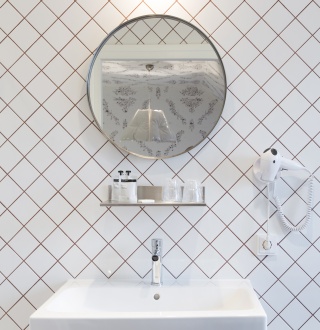
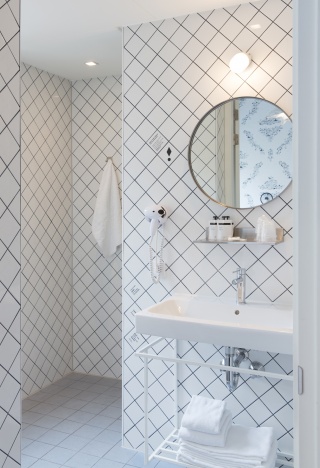
A five-star experience for fifty euros
The name 'Kaboom' suggests an explosion or a clash; a clash between the quality you get and the price you pay for it. Kaboom is housed in a building that dates from 1905. On the outside, the building reflects the architectural style in which it was built – the Amsterdam School. On the inside, it is ultra-modern. 'We constantly strive to create contrasts to keep our guests on their toes,' explains Rino. 'We've incorporated the "kaboom" concept into everything. We hope our guests notice this contrast when they leave and wonder what happened: they spent fifty euros on a room but woke up feeling like they spent the night in a luxury hotel.'
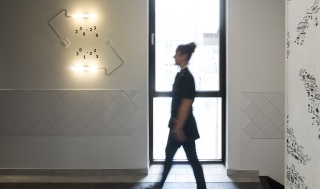
From corridor signs to quality beds
The creative designer turned Kaboom into a no-frills and highly functional hotel. In most hotels, high-traffic areas like corridors tend to show signs of wear and tear due to the constant stream of suitcases and linen carts. For the corridors in Kaboom, the designer opted for partial wall tiling made from diagonal ceramic tiles that protect the walls from damage. This also produces a very striking and unusual look. The partial wall tiling consists of floor tiles from the Scenes collection, and the centre of the corridor features a fabric runner with tiles on either side. There were two key reasons for this design choice: it encourages guests to stick to the runner (as the wheels of their suitcases rattle on the tiles if they stray from the carpeting) and it offers a stylish design solution that minimizes damage. The floor tiles in the corridor are also from the Scenes collection. These high-quality, unglazed, and double-hardened floor tiles are indestructible, scratch-proof, and sustainably produced in Maastricht. This makes them completely vandal-proof, which is exactly what Rino was looking for.
In contrast with most hotels, the linen carts at Kaboom never block the corridors. Here, they are tucked away in specially designed niches in the wall, keeping the corridors free. The slightly recessed room doors create a kind of portico to give guests a homey feeling. That same cosy atmosphere is the first thing guests notice when they enter the lobby. Kaboom limits the number of on-site staff in order to keep their room prices as competitive as possible. Two additional functional design elements in the corridors are the fluorescent tubes on the ceiling that double as signposts and the illuminated arrows that guide guests to their rooms.
This functionality spills into the rooms as well. The high Auping beds were selected for both practical and design purposes. Suitcases can be easily stored under the bed and the room itself is extremely minimalist in design to create maximum living space. This minimalism is also reflected in the simple yet practical clothes rail. Keeping the floors free of clutter makes it easy to clean both the bedroom and the bathroom. This design philosophy helps to minimize costs and maximize efficiency.
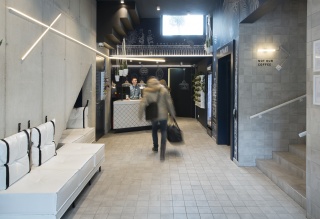
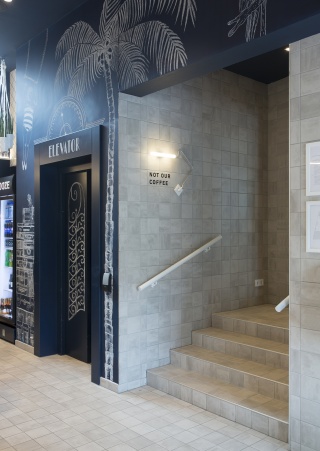
Diagonal contrast
The bathrooms feature tiles from the Colors and Global Collection, with 15 x 15 centimeter tiles for the floors and 10 x 10 centimeter tiles for the walls. The 10 x 10 centimeter high gloss tiles reminded Roger of days gone by – of old-world Paris and the charms of yesteryear. He deliberately sought out this contrast between old and modern by combining uniquely sized diagonal tiles with an ultra-modern rain shower.
Maastricht brand
'The reason I wanted to use Mosa tiles for this project is that there are such strong associations between Mosa and Maastricht. We should be proud of this bit of cultural heritage, as it strengthens the Maastricht brand and vice versa.' Rino adds that a brand like Mosa can really enhance the Kaboom brand. 'Using premium brands makes my own brand premium as well.' Like Mosa, Rino is a strong proponent of the local-for-local principle.
The striking wallpaper in the rooms also reflects the Maastricht brand. 'Guests open their hotel room door and are instantly confronted with something overwhelming. Upon closer inspection, however, they'll notice that the wallpaper tells the story of Maastricht. It features iconic buildings and products that have become a real part of the city,' Rino explains with enthusiasm.
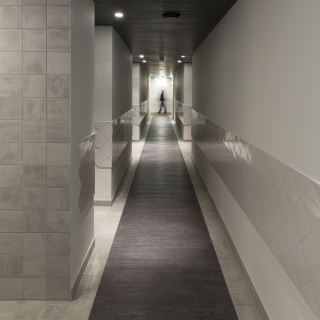
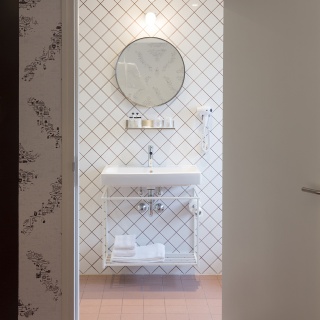
Short lines of communication
Rino has collaborated with Mosa on various hotel concepts over the years and uses Mosa products as standard. 'They have short lines of communication and they're always willing to lend a hand. Mosa also has its own designer, who collaborated with our architect on this project. Together, they came up with extremely useful solutions.' Sometimes, an architect can benefit from discussing or brainstorming with a colleague who knows a lot about the project or a certain element. Mosa offers architects the opportunity to use its products.
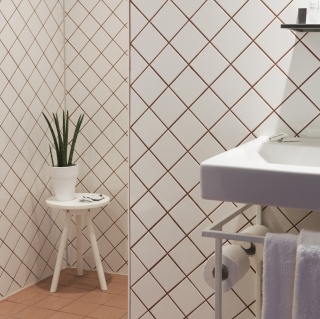
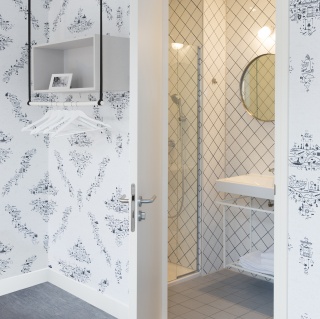
Project details
| Project: | Kaboom Hotel |
| Architect: | INTER/ALTER |
| Location: | Maastricht (the Netherlands) |
| Completion: | 2015 |
| Mosa series: | Scenes, Global Collection, Colors |
Inspiration
More information
We set high standards for the advice and support. This means that we actively aim for dialogue and that we are interested in what interests you. Do you have any questions about this project or would you like to discuss the options for your project?
Contact Mosa